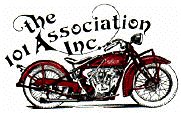It's funny but I have heard no complains about the 101 cylinders that Greg Hutchinson is pouring up for us in, what is it, 15 years now? When I bought a pair, now that it is some time ago, I asked him about the cast iron mix and he was using a blend that is common in heavy duty diesel machines, harder than normal. The cylinders I bought are impossible to distinguish from original and it is very nice to have all fins intact, no rust pits anywhere, crisp threads all over, standard size bore and pristine valve seats!
Nickel coating is by nature quite thin and if you ride in all weathers you have to count on that rust can evolve especially at the very hot spots, heads and exhaust stub. It's the same with most paints.
The 37ci is a lot smoother and feels almost like it is just buzzing along where the 45 is a bit hasher and vibrate a bit more. But I like the added power of a 45. In earlier threads I aired my opinion about a 50ci conversion.
The 37ci crankcase is easy to adapt for the 45 cylinders, it is only the cylinder spigots that is a bit larger on those. The driveshaft, pinionshaft and crank bearings are the same in both engines. And of course everything in the cam and and clutch compartments are the same. And the same carb can be used on both engines.
Flywheels, crankpin, rods and rod bearings, pistons and piston pins, cylinders, heads, valves and valve springs, intake and intake nuts are of different dimensions.
The conversion is very easy done with a complete top end and a complete lower end. Just enlarge the spigot holes, shim the new crankshaft for proper sideplay, bolt on the new cylinders and intake and soon you're off to go! That's in theory, depending on what your plans are, your resources and what you are able to buy ready to assemble.
Be aware that the caged bearings that sometime is supplied or found on the net as replacements for originals has been reported to disintegrate. I don't know the background or frequency of failure, but still a matter of concern. High quality NEW original style, loose steel cages, from a well reputed supplier are not failsafe either, but a better choice in my opinion. Cages that are worn adds to friction and heat in the bearing. Old cages often can be found warped or with a prong bent.
Old or weak valve springs should not be reused, it'll wear the seats rapidly when the valves are bouncing. They are subjected to a lot of heat that may soften them. If you can't check them in a spring tester then it is better to change springs for new at every valve service.
Another improvement is the new plastic rings for the intake. They don't need to be torqued as hard as the brass originals and that lessens the risk substancially of dislocating the nipple in the cylinder. Trust me on that...


